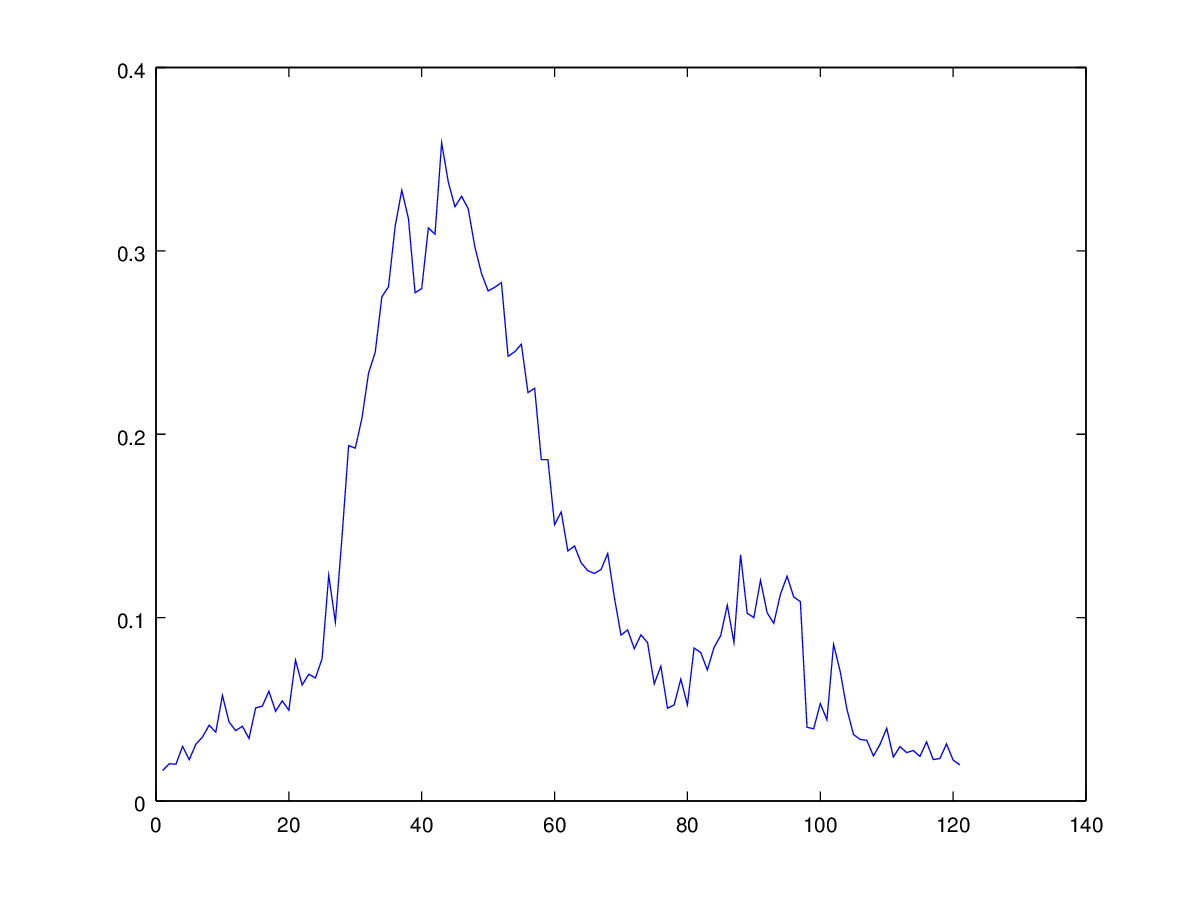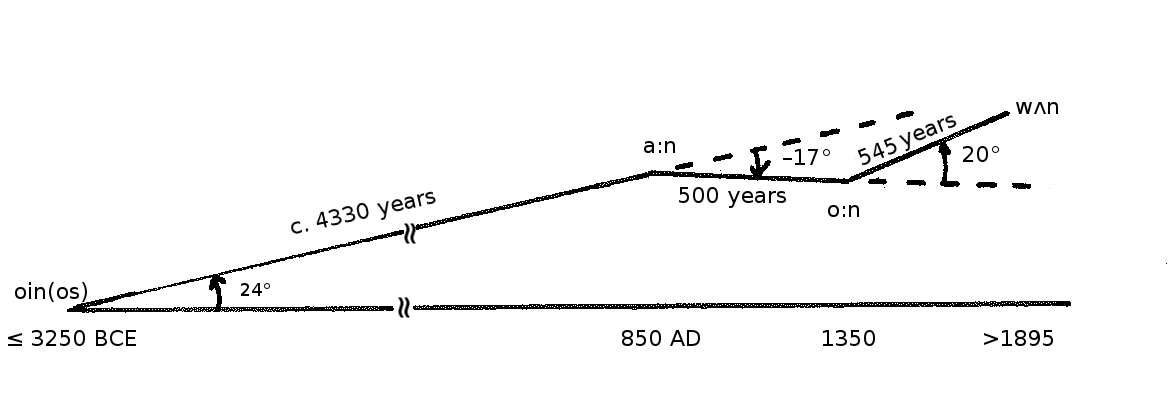| Vowel raising (open to mid) |
[a] > [e] |
in |
[axt] > [eçt] |
(aeht-to-echt.wav) |
| Vowel raising (open to mid) |
[æ] > [eɪ] |
in |
[dæʃmʔ] > [teɪçn] |
(deshimt-to-teichn.wav) |
| Vowel raising (open to mid) and rounding |
[ɑ:n] > [o:n] |
in |
[ɑ:n] > [o:n] |
(an-to-one.wav) |
| Vowel raising (mid to close)/monophthongization |
[ei] > [i:] |
in |
[nein] > [ni:n] |
(neGn-to-niin.wav) |
Vowel raising (mid to close)/glide formation
|
[o] > [w] |
in |
[o:n] > [won] |
(oon-to-one.wav) |
Vowel raising (open to close) and monophthongization
|
[wɑ:] > [u:] |
in |
[twɑ:] > [tu:] |
(twa-to-two.wav) |
|
|
|
|
|
Monophthongization
|
[jaʊ] > [ɔ] |
in |
[fjaʊəɾ] > [fɔə] |
(feower-to-four.wav) |
Monophthongization
|
[aʊə] > [ɔ:] |
in |
[faʊəɾ] > [fɔə] |
(fowre-to-four.wav) |
|
|
|
|
|
Mid-centralization with unrounding
|
[o] > [ə] |
in |
[oxto] > [oxtə] |
(okto-to-oxte.wav) |
|
|
|
|
|
De-frication and voicing
|
[ç] > [ɪ] |
in |
[eçt] > [eɪt] |
(echt-to-eight.wav) |
De-frication/vocalization and monophthongization
|
[eɪʝ] > [e:] |
in |
[teɪʝnə] > [te:nə] |
(teichne-to-tene.wav) |
De-frication/vocalization
|
[ɣ] > [i] |
in |
[neɣn] > [nein] |
(neGn-to-nain.wav) |
|
|
|
|
|
Vowel opening (close to open)/diphthongization
|
[i:] > [aɪ] |
in |
[fi:f] > [faɪv] |
(fif-to-five.wav) |
| Vowel opening (close to open)/diphthongization |
[i:] > [ai] |
in |
[ni:n] > [nain] |
(niin-to-nain.wav) |
Vowel opening (close-mid to open-mid)
|
[e:] > [ɛ] |
in |
[te:nə] > [tɛn] |
(tene-to-ten.wav) |
Vowel opening (close-mid to open-mid) and monophthongization
|
[ei] > [ɛ] |
in |
[treis] > [trɛ] |
(treis-to-tre.wav) |
Vowel opening (mid to open) with unrounding
|
[o] > [ʌ] |
in |
[won] > [wʌn] |
(an-to-one.wav) |
Vowel opening (mid to open) with unrounding
|
[o] > [ɑ] |
in |
[oxtə] > [ɑxtə] |
(oxte-to-aehta.wav) |
Vowel opening (mid to open) and unrounding
|
[o:] > [ɑ:] |
in |
[two:] > [tʋɑ:] |
(twoa-to-twa.wav) |
Vowel opening (open-mid to open) with
unrounding/monophthongization
|
[ɔi] > [ɑ:] |
in |
[ɔin] > [ɑ:n] |
(oin-to-an.wav) |
|
|
|
|
|
Vowel fronting
|
[ɑ] > [a] |
in |
[oxtə] > [ɑxtə] |
(oxte-to-aehta.wav) |
Velar-to-palatal fronting
|
[x] > [ç] |
in |
[axt] > [eçt] |
(aeht-to-echt.wav) |
|
|
|
|
|
Bilabial-to-alveolar backing
|
[m] > [n] |
in |
[dæʃmʔ] > [teɪçn] |
(deshimt-to-teichn.wav) |
Postalveolar-to-palatal backing
|
[ʃ] > [ç] |
in |
[dæʃmʔ] > [teɪçn] |
(deshimt-to-teichn.wav) |
Labio-dentalization
|
[w] > [ʋ] |
in |
[two:] > [tʋɑ:] |
(twoa-to-twa.wav) |
Frication
|
[p] > [f] |
in |
[pɪmp] > [fɪmf] |
(pimp-to-fimf.wav) |
Frication
|
[t] > [θ] |
in |
[trɛ] > [θrɛ] |
(tre-to-thre.wav) |
Frication
|
[k] > [x] |
in |
[okto] > [oxto] |
(okto-to-oxte.wav) |
|
|
|
|
|
| Loss of weak final [ə] |
|
in |
[te:nə] > [tɛn] |
(tene-to-ten.wav) |
| Loss of final [ħ] |
|
in |
[dwoħ] > [two:] |
(dwo-to-twoa.wav) |
| Loss of postvocalic [ɾ] |
|
in |
[fjaʊəɾ] > [fɔə] |
(feower-to-four.wav) |
| Loss of final [s] |
|
in |
[ɔins] > [ɔin] |
(oins-to-oin.wav) |
| Loss of final [s] |
|
in |
[treis] > [trɛ] |
(treis-to-tre.wav) |
|
|
|
|
|
| Voicing |
[ç] > [ʝ] |
in |
[teɪçnɐ] > [teɪʝnɐ] |
(teichne-to-tene.wav) |
| Devoicing |
[d] > [t] |
in |
[dwoħ] > [two:] |
(dwo-to-twoa.wav) |
Denasalization and vocalization
|
[m] > [i] |
in |
[fimf] > [fi:f] |
(fimf-to-fif.wav) |
| Stress movement |
|
in |
[oxtó] > [óxtə] |
(okto-to-oxte.wav) |


